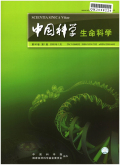- 钛学术文献服务平台 \
- 学术期刊 \
- 基础科学期刊 \
- 自然科学总论期刊 \
- 中国科学(生命科学)期刊 \
null
Analysis of genotypes and phenotypes in Chinese children with tuberous sclerosis complex
基本信息来源于合作网站,原文需代理用户跳转至来源网站获取
摘要:
Tuberous sclerosis complex (TSC) is a neurocutaneous syndrome with serious clinical presentations,an autosomal dominant genetic disorder involving multiple organs and systems.We retrospectively investigated the clinical manifestations and genotypes of 20 Chinese children with TSC to enable informed diagnostic and surveillance recommendations in China.A retrospective analysis of clinical manifestations in 20 children (7.00±5.30 years old) with TSC was conducted.A genetic testing of the genes TSC1 and TSC2 was performed in 14 children.The earliest manifestations of TSC were skin lesions (80% of patients) and seizures (75%).Fourteen of the children presented with retinal hamartomas,and 2 of these underwent eye enucleation at other hospitals through misdiagnosis.On magnetic resonance imaging,18 children exhibited subependymal nodules,and 16 ones showed cortical nodules.5 cases of non-renal hamartomas,5 cases of multiple renal cysts,and 5 cases of cardiac rhabdomyomas were observed.The genotyping of TSC1 and TSC2 in 14 children revealed 11 with mutations in TSC2,2 with mutations in TSC1,and no mutations of either gene in one patient.Eight of these observed mutations are reported here in for the first time.The illness presentations of the TSC2-mutated patients were more severe than that of patients carrying TSC1 mutations.There were differences in the mutations of TSC genes in Chinese children from those reported in other countries.The described clinical characteristics and genotyping will help pediatric neurologists to understand,diagnosis,and treat TSC.

推荐文章
期刊_丙丁烷TDLAS测量系统的吸收峰自动检测
带间级联激光器
调谐半导体激光吸收光谱
雾剂检漏 中红外吸收峰 洛伦兹光谱线型
不同盐度、温度及光照对漂浮浒苔生理生态的影响
浒苔
盐度
温度
光照
生理生态
期刊_联合空间信息的改进低秩稀疏矩阵分解的高光谱异常目标检测
高光谱图像
异常目标检测 低秩稀疏矩阵分解 稀疏矩阵 残差矩阵
内容分析
关键词云
关键词热度
相关文献总数
(/次)
(/年)
文献信息
| 篇名 | Analysis of genotypes and phenotypes in Chinese children with tuberous sclerosis complex | ||
| 来源期刊 | 中国科学(生命科学) | 学科 | |
| 关键词 | |||
| 年,卷(期) | 2017,(7) | 所属期刊栏目 | |
| 研究方向 | 页码范围 | 763-771 | |
| 页数 | 9页 | 分类号 | |
| 字数 | 语种 | 中文 | |
| DOI | 10.1007/s11427-017-9091-x | ||
五维指标
引文网络
引文网络
二级参考文献 (21)
共引文献 (3)
参考文献 (33)
节点文献
引证文献 (0)
同被引文献 (0)
二级引证文献 (0)
1900(4)
- 参考文献(2)
- 二级参考文献(2)
1991(1)
- 参考文献(1)
- 二级参考文献(0)
1993(1)
- 参考文献(1)
- 二级参考文献(0)
1995(2)
- 参考文献(1)
- 二级参考文献(1)
1996(1)
- 参考文献(1)
- 二级参考文献(0)
1997(1)
- 参考文献(1)
- 二级参考文献(0)
1998(2)
- 参考文献(1)
- 二级参考文献(1)
1999(5)
- 参考文献(3)
- 二级参考文献(2)
2000(1)
- 参考文献(1)
- 二级参考文献(0)
2001(2)
- 参考文献(1)
- 二级参考文献(1)
2002(2)
- 参考文献(1)
- 二级参考文献(1)
2006(5)
- 参考文献(3)
- 二级参考文献(2)
2007(5)
- 参考文献(2)
- 二级参考文献(3)
2008(1)
- 参考文献(1)
- 二级参考文献(0)
2010(1)
- 参考文献(1)
- 二级参考文献(0)
2011(1)
- 参考文献(1)
- 二级参考文献(0)
2012(4)
- 参考文献(2)
- 二级参考文献(2)
2013(3)
- 参考文献(2)
- 二级参考文献(1)
2014(7)
- 参考文献(4)
- 二级参考文献(3)
2015(4)
- 参考文献(2)
- 二级参考文献(2)
2016(1)
- 参考文献(1)
- 二级参考文献(0)
2017(0)
- 参考文献(0)
- 二级参考文献(0)
- 引证文献(0)
- 二级引证文献(0)
引文网络交叉学科
相关学者/机构
期刊影响力
中国科学(生命科学)
主办单位:
中国科学院
出版周期:
月刊
ISSN:
1674-7232
CN:
11-5840/Q
开本:
出版地:
北京东黄城根北街16号
邮发代号:
创刊时间:
语种:
chi
出版文献量(篇)
2757
总下载数(次)
7
总被引数(次)
26341
期刊文献
相关文献
推荐文献
- 期刊分类
- 期刊(年)
- 期刊(期)
- 期刊推荐
力学
化学
地球物理学
地质学
基础科学综合
大学学报
天文学
天文学、地球科学
数学
气象学
海洋学
物理学
生物学
生物科学
自然地理学和测绘学
自然科学总论
自然科学理论与方法
资源科学
非线性科学与系统科学
中国科学(生命科学)2022
中国科学(生命科学)2021
中国科学(生命科学)2020
中国科学(生命科学)2019
中国科学(生命科学)2018
中国科学(生命科学)2017
中国科学(生命科学)2016
中国科学(生命科学)2015
中国科学(生命科学)2014
中国科学(生命科学)2013
中国科学(生命科学)2012
中国科学(生命科学)2011
中国科学(生命科学)2010
中国科学(生命科学)2009
中国科学(生命科学)2008
中国科学(生命科学)2007
中国科学(生命科学)2006
中国科学(生命科学)2005
中国科学(生命科学)2004
中国科学(生命科学)2003
中国科学(生命科学)2002
中国科学(生命科学)2001
中国科学(生命科学)2000
中国科学(生命科学)1999
中国科学(生命科学)2017年第9期
中国科学(生命科学)2017年第8期
中国科学(生命科学)2017年第7期
中国科学(生命科学)2017年第6期
中国科学(生命科学)2017年第5期
中国科学(生命科学)2017年第4期
中国科学(生命科学)2017年第3期
中国科学(生命科学)2017年第2期
中国科学(生命科学)2017年第12期
中国科学(生命科学)2017年第11期
中国科学(生命科学)2017年第10期
中国科学(生命科学)2017年第1期

 免费查重
免费查重










